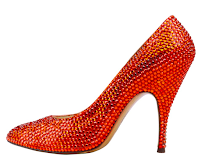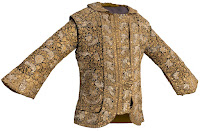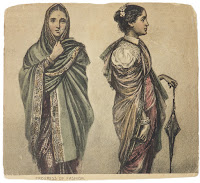What we wear tells a lot about our social identity, our customs, our habits and where we come from. It's appropriate to say that we don’t just wear clothes – we wear our culture!
Highlighting this very aspect, we at Google Arts & Culture have launched an exciting new project “We wear culture” that showcases 3000 years of fashion from across 42 countries in partnership with 183 world famous museums, fashion councils and universities. Using state of the art technology, including Virtual Reality, 360º videos and Gigapixel images, the platform enables unique online access to historic and contemporary stories that decode the various aspects of fashion for everyone. The stories, photos, videos and VR experiences will appeal to all those who are curious about its various intersections with music, pop culture, dance, technology, economics and so much more.
So if you want to know more about the ancient Silk Road, or the courtly fashions of Versailles, to how the Vivienne Westwood Corset came to be reconceived as a symbol for sexual empowerment, or the origin of the British punk or the stories behind the clothes you wear today, it’s all there at g.co/wewearculture. Perhaps you’re looking for more? You can explore even the Iconic pieces that changed the way generations dressed, be it Marilyn Monroe’s famous Ruby Slipper by Salvatore Ferragamo or the Black Dress by Chanel. It’s there for you to explore, at your fingertips and at your leisure.
Vivienne Westwood Corset courtesy Victoria & Albert Museum; Ruby Slipper of Marilyn Monroe courtesy Museo Salvatore Ferragamo
The Richness and diversity of Indian Fashion has always been marked by its distinctive and varied craftsmanship, it’s fabrics, the weaves, the natural dyes and vibrant colours as well as the classic Indian drape - the iconic Indian Saree. It would be apt to say that the most versatile garment in the world, the saree, is referenced the world over and worn by millions of women on a daily basis.
To celebrate the rich history of this iconic nine yards, Border & Fall in The Sari Project have explored 60 regional draping styles. You can also view in detail the varied weaves from across India, from Gharchola to Patola to Temple to Ikat sarees or trace the story and importance of Indian textiles from ancient sculptures, to heirloom textiles and how events such as Gandhi’s Khadi Movement influenced the craftsmanship from Chhatrapati Shivaji Maharaj Vastu Sangrahalaya (CSMVS). Available online from the CSMVS collection are the heirloom sarees of the Tagore family and that of Homi J. Bhabha’s family.
Various sari drapes courtesy Border&Fall
Of the people, of the land. There is plenty of regional textile and fashion heritage to be discovered. You can revisit the colonial Indian fashion with Dr. Bhau Daji Lad Mumbai City Museum, and trace the story of the history and impact of cotton in early trade of textiles. Then there are the designs from north-eastern India including the weaves of tribes such as the Nagas, Meitis and the traditional attire from Meghalaya called ‘Dhara’ or ‘Nara’ worn by the Khasi women during special occasions, made up of costly Mulberry and Eri silk yarn. From down south, view Salar Jung Museum’s exhibits capturing the dress and fashion of royal attires of the Nizams from 19th century Hyderabad (part of Deccan region). Revisit the art of Brocades, Patola and Baluchari with a special exhibit by Museum of Art and Photography.
Navjote ceremony coat of Cursetjee Vakil courtesy CSMVS; Ethnographic documentation of drape styles courtesy CSMVS; Salar Jung III in a sherwani courtesy Salar Jung Museum
The SEWA Hansiba Museum in Randhapur is completely owned and managed by rural women artisans. The museum contains heirlooms by the local communities, such as the Ahir, Rabari and Harijan. The local skilling has helped bond stronger communities, and top fashion designers are now approaching them for fashion sampling. Flamboyant stitches to regional exchanges, the women are building economic security for themselves.
If it is colour that catches your interest, then explore how Indigo cultivation dates back to the Indus Valley civilisation and how this natural dye has been often credited with opening up an extensive range of beautiful blue shades that redefined global fashion even as the knowledge of extracting blue color from green leaves of indigo was closely guarded within the families. You don’t have to stop at Indigo or India, you can explore the colour palette of global fashion over the years.
With over over 400 online exhibitions and stories sharing a total of 30.000 photos, videos and other documents; 4 virtual reality experiences of iconic fashion pieces; over 700 ultra high-resolution gigapixel images and over 40 venues offer backstage access on Google Street View you could easily get lost in fashion!
We could not have done this it without our partners around the globe. In India we are very proud to partner with Chhatrapati Shivaji Maharaj Vastu Sangrahalaya (CSMVS), Dr. Bhau Daji Lad Mumbai City Museum (BDL), SEWA Hansiba Museum, Salar Jung Museum, Indian Museum Kolkata, Museum of Art & Photography, Craft Revival Trust, Avani Society, Worldview Impact Foundation, Border & Fall to celebrate this rich history of Indian fashion and bring to life the creativity, heritage and craftsmanship -- for anyone around the world to see, learn, experience and cherish. The new online exhibition opens today at g.co/wewearculture online for free and will also be available through the Google Arts & Culture mobile app both on iOS and Android.
Posted by Simon Rein, India Programme Manager, Google Arts & Culture




